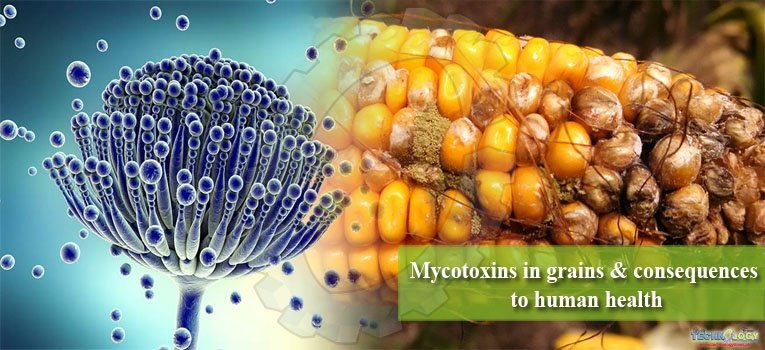Mycotoxins are toxic secondary metabolites produced by filamentous fungi (mold) developing on grains before reaping and in storage which can contaminate food and feed worldwide.

Only some fungi produce mycotoxins, and these are referred to as toxigenic. There are several mycotoxins known to exist however just a set number of toxins are considered significant health hazards.
Grains
Cereals are primary source of carbohydrates in the daily routine of individuals around the world, they represent the main source of mycotoxins in food. Cereals can easily be infested with fungi in various stages of production and storage. A large number of mycotoxins can be found in cereals, and many countries have enacted legislation on maximum allowed levels of mycotoxins in cereals.
Corn grain is considered to be the grain most highly contaminated with mycotoxins, followed by rice, barley and wheat, oilseeds and seeds of peanuts, soybeans and sunflower. The combination of more toxins is a pressing problem for the detection of mycotoxins, as well as for the monitoring of the effects that they exert in the body of humans and animals.
Mycotoxins
The five principle mycotoxins which affect cereals are: aflatoxins, deoxynivalenol, zearalenone, fumonisins and ochratoxin A. The fungi’s which develop is dependent on the environmental conditions during pollination and early grain development (Table 1).
These mycotoxins are stable and persistent. They can cause serious health problems for humans and animals at low levels and economic repercussions for the farmer who often has to destroy contaminated crop. There is usually no treatment for mycotoxin poisoning (myocotoxicosis). Clinical symptoms usually subside upon removal of contaminated food or feed.
Table 1: The favorable environmental conditions for fungi which produce mycotoxins.
Mycotoxins | Fungi | Favorable Conditions |
Aflatoxins | Aspergillus flavus Aspergillus parasiticus | Hot and dry. Drought |
Deoxynivalenol Zearalenone | Fusarium graminearum Fusarium culmorum | Cool, wet, humid at grain fill |
Fumonisins | Fusarium verticillioides Fusarium proliferatum | Warm to hot, dry at and after floweing |
Ochratoxin A | Penicillium verrucosum | Dependent on harvest conditions |
Due to the fact mycotoxins have a toxic effect on humans and animals, it is essential to have an understanding of the toxin levels in food worldwide in order to establish and implement proper management strategies. Thus, this case study will review the mycotoxin deoxynivalenol in wheat.
Deoxynivalenol (DON)
Deoxynivalenol (also known as vomitoxin or VOM) is produced principally by the fungus F. graminearum and in some geographical areas by F. culmorum. Corn and small grains such as wheat, oats and barley are the major crops affected.
The organisms survive on residues left on the field from the previous season’s crop, providing an inoculum source for the new crop. The fungi organisms are windblown to the anthers of small grains, where it penetrates the floret and produces disease, known as Fusarium Head Blight (FHB) and mycotoxin contamination of the grain.
Fusarium mycotoxins are found in all European cereal-growing regions affecting small grain cereals. The heads of wheat crop suffering from Fusarium Head Blight appear premature and ripen unevenly. At harvest, the kernels will have a blanched appearance and may be stained pink, known as pink scab.
Food Safety
Poultry and swine are the animals most affected by grains contaminated with this toxin. Consumption has led to vomiting in the animal and levels above 1µ/g are considered potentially harmful. Pet foods prepared with wheat contaminated with this toxin have also been involved in acute intoxications.
The major source of human exposure to mycotoxins is consumption of contaminated foods. Exposure is highest when those foods are dietary staples, such as maize, groundnuts, or various other cereals. Exposures to metabolites or parent toxins may also occur by consumption of contaminated milk and milk products.
The human health effects considered here encompass acute poisoning, cancer, other chronic diseases, and biological effects, including growth impairment and immunomodulation. One of the major limitations in assessing the effects of mycotoxins on health has been the inability to accurately assess exposure at the individual level.
Humans are thought to exhibit similar vomiting syndrome when consuming DON-contaminated grain. However, human exposure and responses to the toxin are ill-defined. One incident which occurred in Kashmir Valley of India in 1987 illustrates the potential consequences to human health from DON’s.
In this incident several thousand people suffered from gastrointestinal distress, 97 of which reported feelings of illness and mild to moderate abdominal pain after consuming a meal consisting of locally produced or homemade wheat bread.
Other reported symptoms included: throat irritation, diarrhea, vomiting, blood in stools, facial rash and upper respiratory tract infections. Illness subsided when consumption of the bread ceased. Samples of flour and wheat in the market contained DON and provided solid evidence for the potential health implications of fairly low exposure to DON. More work is required to define human risk from this food-borne contaminant.
Managing Mycotoxins
Mycotoxins can enter the food chain at any point, particularly during production and storage, with varying severity. It is estimated that one quarter of the world’s crops are contaminated to some extent with mycotoxins.
The risk is increased when environmental conditions including those during shipping, handling and storage practices are conductive to mold growth. Worryingly, many mycotoxins survive processing and may not be detectable once it is processed into foods and meals.
A food safety management system based on Hazard Analysis Critical Control Point (HACCP) is advocated. This management system aims to control contamination throughout production and post production operations i.e. risk is addressed and reduced at every phase from production to the final consumer to ensure hazards associated with mycotoxin contamination have been minimized.
Authors: Muhammad Adeel Arshad1, Nauman Iftikhar2, Shehryaar Shahid1, Wasim Yousaf1, Shakeel Anjum3
- Institute of Animal and Dairy Sciences, University of Agriculture, Faisalabad
- Department of Parasitology, University of Agriculture, Faisalabad
- Department of Entomology, University of Agriculture, Faisalabad